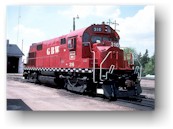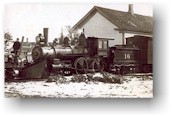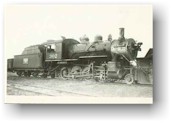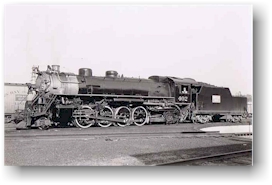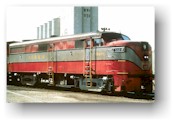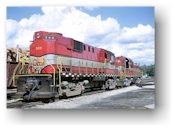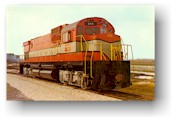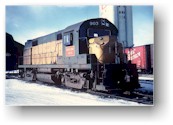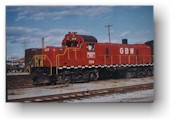|
Home
|
Power on the Green Bay Route: How a Wisconsin short line transformed itself into a high-speed bridge line.
- Loco Roster
- Locomotive rosters for all Green Bay Route lines:
Diesel Roster - abbreviated or expanded or list
Steam Roster - abbreviated or expanded or list - Locomotive Photos
- Steam
- Diesel
- Paint Schemes
- Information on the introduction of all-red loco paint scheme.
- Then and Now...
- Green Bay Route diesels that came from other railroads, and those that went to others.
- 17 Reasons...
- Seventeen red-and-gray reasons to love the Green Bay Route.
- GB&W Power:
- Read on for the story of power on the Green Bay Route.
Index |
Early Steam |
Early Steam |
In the early years, the Green Bay Route was powered by a fleet of
standard 4-4-0 locomotives. Switching duties were handled by 0-4-0 and
0-6-0 engines.
All early locos were named after investors in the railroad or key terminal locations. A successful rebuilding program in the early 1900s extended the lives of many of the 4-4-0s: one of them (#23) was used on the Waupaca Branch until 1941. As World War One approached, longer and heavier trains ushered in the first Mogul (2-6-0) locomotives. Eventually, the Green Bay Route acquired seventeen of these machines and they became a mainstay of power on the railroad for freight and passenger service alike, often doubleheading on long freights. Increased auto parts business via the carferry connections led to addition of seven Consolidation (2-8-0) engines to the roster in the 1920s to power cross-state fast freights. |
Modern Steam |
A few of the earliest locomotives on the subsidiary lines (Ahnapee &
Western, Kewaunee Green Bay & Western, Waupaca - Green Bay, Iola
& Northern) were used engines of various heritages. The 1920s saw
the addition of other used locomotives to the roster - notably a fleet
of ex-New York Central 0-6-0 switch engines assigned to the yards and
the paper mills in Green Bay and Wisconsin Rapids, and three 2-8-0
Consolidations from the bankrupt Chicago, Peoria & St. Louis.
The pinnacle of steam power on the Green Bay Route arrived with the first Mikado (2-8-2) locomotives delivered in 1937. A modernization program in the late 1930s lead to 60 miles-per-hour track speeds, reduced grades, and strengthened bridges -- and these modern locomotives from Alco were built to suit the bill. The Consolidations were moved to way freight service and the Moguls were scrapped. Mikado #406 was the last steam locomotive purchased by the railroad, in 1939. |
Arrival of the Diesels |
Just as the Mikados were being added to the
roster a new breed of locomotive appeared: diesel-electric power. A
six-hundred horsepower Alco HH-600 diesel-electric switcher was assigned
to Norwood yard in Green Bay in 1938. The ability of the diesel to
operate with little down time made it ideally suited to yard work and it
was soon joined by several more switchers for work at Wisconsin Rapids
and Winona.
A decade later dieselization came in a big way with addition of five sleek FA-1 locos for fast freight duty. The purchase was followed by RS-2 road switchers in 1950 and the Mikados were taken from the roster, removed to uselessness far before their allotted time was up. Steam power was gone from the mainline of the Green Bay Route. The Ahnapee & Western followed suit in the early 1950s when two General Electric 70-ton switchers replaced the consolidations on the Casco to Sturgeon Bay line. Additional Alco road switchers -- RS-3s, RS-11s, and RS-27s -- were added throughout the next decade, delivered in groups of one and two units as traffic levels increased on the railroad. At the time of its arrival in 1960, RS-27 #310 was the highest horsepower four-axle locomotive in the world, well suited to the fast freight operation of the railroad. A new generation of diesel locomotives arrived with Alco's new "Century" series in 1963. The Green Bay Route added new 2400 horsepower C-424s at about the rate of one a year in the early 1960s, retiring one of the PA-1s for each new loco added. The high speed stakes were raised even higher in 1968 with a purchase of a 3000 horsepower Alco C-430. |
Used and Rebuilt Locomotives |
Alco had been struggling financially ever since coinverting to
diesel-electric production, and finally quit producing new locomotives
in 1969. The Green Bay Route, with a shop crew skilled in the
particulars of keeping their engines in working order, stuck with Alco
by rehabilitating their aging fleet and purchasing additional used
locomotives and as conditions warranted. Several RS-27s of Chicago &
North Western heritage were added in the late 1960s and 1970s, and the
five final additions to the roster were Alco Century units with rebuilt
electronics that were purchased used in 1980 from excess inventory after
the formation of Conrail. The Ahnapee & Western sold their two
switchers in 1972 and relied on GB&W trains to service industries on
the line after that time.
The most notable of the rebuilds performed at the Green Bay shops were the conversion of the GBW RS-3s to "RS-20s": the old locomotives were rebuilt with a 2000-horspower Alco 251 engine, additional weight, and a chopped nose for shoot-hood-forward operation. The engines spent their remaining years as yard and industry switchers in Green Bay and Wisconsin Rapids. It is a tribute to the Green Bay Route's shop forces that all four locos were still on the roster when the railroad was sold in 1993. Other rebuilds included Alco units for (sister company) Little Rock & Western, Continental Grain Company, and even remotoring an ex-GBW RS-2 which was previously sold to the Michigan Northern RR. |
